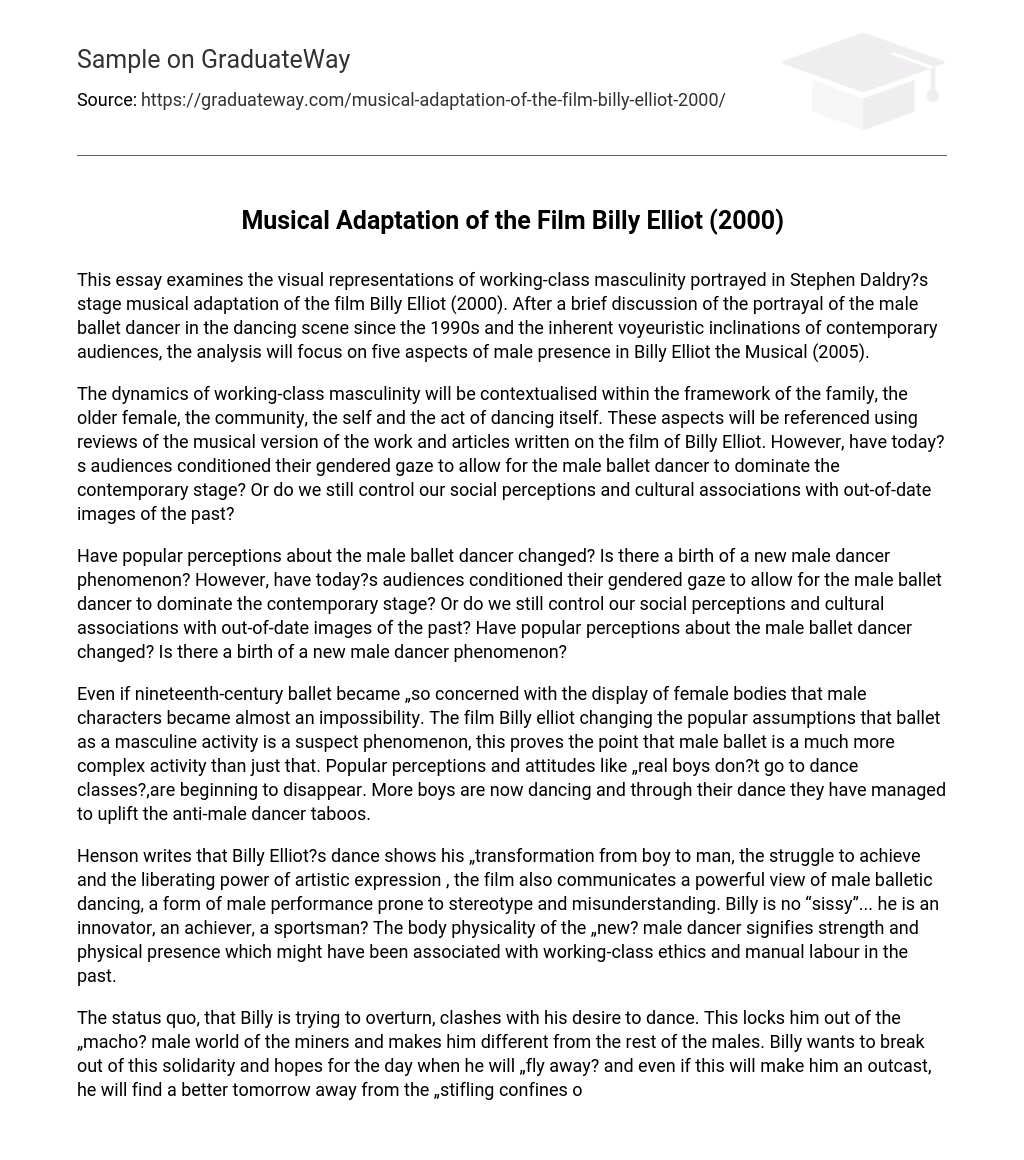This essay examines the visual representations of working-class masculinity portrayed in Stephen Daldry?s stage musical adaptation of the film Billy Elliot (2000). After a brief discussion of the portrayal of the male ballet dancer in the dancing scene since the 1990s and the inherent voyeuristic inclinations of contemporary audiences, the analysis will focus on five aspects of male presence in Billy Elliot the Musical (2005).
The dynamics of working-class masculinity will be contextualised within the framework of the family, the older female, the community, the self and the act of dancing itself. These aspects will be referenced using reviews of the musical version of the work and articles written on the film of Billy Elliot. However, have today?s audiences conditioned their gendered gaze to allow for the male ballet dancer to dominate the contemporary stage? Or do we still control our social perceptions and cultural associations with out-of-date images of the past?
Have popular perceptions about the male ballet dancer changed? Is there a birth of a new male dancer phenomenon? However, have today?s audiences conditioned their gendered gaze to allow for the male ballet dancer to dominate the contemporary stage? Or do we still control our social perceptions and cultural associations with out-of-date images of the past? Have popular perceptions about the male ballet dancer changed? Is there a birth of a new male dancer phenomenon?
Even if nineteenth-century ballet became „so concerned with the display of female bodies that male characters became almost an impossibility. The film Billy elliot changing the popular assumptions that ballet as a masculine activity is a suspect phenomenon, this proves the point that male ballet is a much more complex activity than just that. Popular perceptions and attitudes like „real boys don?t go to dance classes?,are beginning to disappear. More boys are now dancing and through their dance they have managed to uplift the anti-male dancer taboos.
Henson writes that Billy Elliot?s dance shows his „transformation from boy to man, the struggle to achieve and the liberating power of artistic expression , the film also communicates a powerful view of male balletic dancing, a form of male performance prone to stereotype and misunderstanding. Billy is no “sissy”… he is an innovator, an achiever, a sportsman? The body physicality of the „new? male dancer signifies strength and physical presence which might have been associated with working-class ethics and manual labour in the past.
The status quo, that Billy is trying to overturn, clashes with his desire to dance. This locks him out of the „macho? male world of the miners and makes him different from the rest of the males. Billy wants to break out of this solidarity and hopes for the day when he will „fly away? and even if this will make him an outcast, he will find a better tomorrow away from the „stifling confines of the enclosed and embattled community. Billy and his brother are fighting for two different ideals: personal individuality and solidarity.
Billy wants to break free, his brother fights to maintain the male traditions of colliery workers. The strong masculine activity of boxing, which could potentially double as a self-defence exercise for young Billy, is one of the more accepted forms of recreation for young males, even in today?s working-class societies. Boxing requires focused energy and constant alertness. But, so does dance. Billy sees dancing „just like sport? and not „prancing about like a fruit?.
In this way, he is also trying to convince the members of his family (and his community) that dance is indeed a valid and acceptable activity. And by doing this, he celebrates his individuality by having secret dance classes and keeps his promise to his dead mother?s request to „always be? himself. In conclusion Billy chooses to free himself from the solidarity and ordinariness of his working-class male surroundings and find refuge in the ballet classes.
Even if dance involves pain, emotional and physical strain, he challenges the conventionality of his own masculinity by self-improvement. His efforts are focused on getting the dance right. Alan Sinfield comments, on the other hand, on Billy?s escape saying that „[t]here is no prospect here of transforming the system. The struggle is to maintain it! Solidarity is important for consolation and respect. Billy Elliot escapes, largely because the system is already permeable?





